The Vegetative Stage: Everything There Is To Know About It
- What is the cannabis vegetative stage
- Changes in weed plants during the veg stage
- The best chance of success
- The right grow lights
- Watering
- Cannabis nutrients
- The right grow room environment
- How long does the marijuana veg stage last
- How the vegetative stage affects yields
- 4 tips for a perfect vegetative stage

Like all plants, marijuana goes through various growth stages. But if you’re looking into home cultivation, you don’t have the luxury of allowing these things to happen naturally.
A lot goes on during the weed vegetative stage that requires constant monitoring and razor-sharp precision. This stage lays the foundation for a high, robust final yield.
Let’s take a look at the vegetative stage, how it works, and how to handle it.
What Is The Marijuana Vegetative Stage?
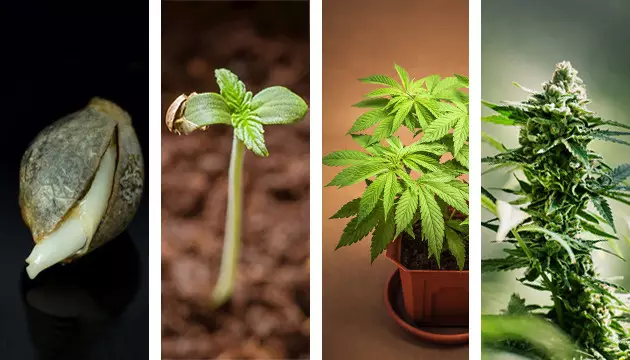
| Germination | Seedling | Vegetation | Flowering |
The vegetative stage (or vegetative phase) is the second-last phase in the cannabis plant’s lifecycle. It’s preceded by the germination and seedling stages, with the flowering stage following after. This is also the time when you must keep an out for and remove any male marijuana plants.
Due to the vegetative stage being a point of rapid development, you’ll need to change the way you maintain your plant and its environment. The following sections explore the concept in greater detail.
What Happens To Your Weed During The Vegetative Stage?
During the germination and seedling stage, there isn’t much to see. Stems and leaves will sprout, but the leaves will have one blade. Once the vegetative weed stage kicks in, however, you’ll notice things really taking off, with stems growing and leaf blades increasing. Below the surface, small roots grow and spread out quickly.
Growth speeds up exponentially, where stalks and leaves develop per their genetics. Sativas are tall and thin with leaves spread out, while Indicas are short and bushy with thicker foliage.
What To Do During The Vegetative Weed Stage
The weed vegetative stage is a delicate time when your actions will significantly impact the final yield. Unfortunately, this also means there’s a lot that could go wrong. Vigilance and strict procedure give you the best chance of success.
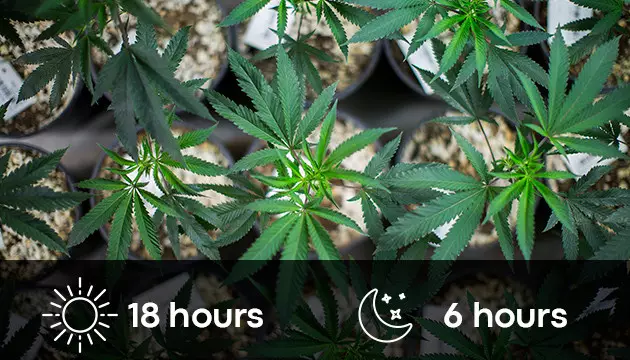
Choose The Right Grow Lights
During the vegetative stage, weed needs 18 hours of light per day (auto-flowering plants excepted).
In terms of grow lights, there’s no “best” option. It all depends on your budget, although more complicated equipment tends to make growing significantly easier.
That being said, one essential component during the vegetative stage is blue spectrum light. This applies to all plants, but with cannabis, a healthy helping of blue light keeps plants shorter and bushier – a great advantage when growing Sativas, which are naturally taller.
Some growers simply leave their lights on 24/7 – they claim this is an effective way to push more growth, leading to better yields. However, this usually also forces the vegetative stage to continue for longer. For the vegetative phase to progress naturally, you have to simulate night and day cycles. Provide 18 hours of light followed by 6 hours in the dark throughout the vegetative stage.
Watering During The Vegetative Stage
If you’re just growing a handful of plants, a simple watering can does the trick. However, if you have a massive grow room running, you might need something more efficient like a sprinkler or liquid transfer pump.
Regardless, the vegetative stage marks a notable increase in water demand. Watch out for signs of dehydration, such as yellowing leaves.
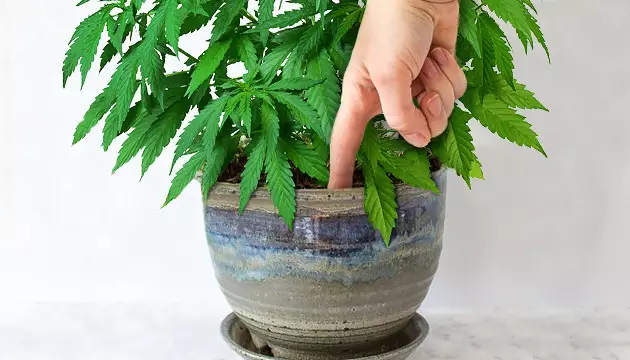
It’s easy to know when to water cannabis. Simply feel for dry topsoil, then push your finger down about an inch. If it’s still dry, add water near the base and extend outward, ensuring that all the roots can access water.

Cannabis Nutrients For Vegetative Growth
Just like humans, plants need nutrients to thrive. One critical nutrient for cannabis is nitrogen. A nitrogen deficiency is a guaranteed way to grind your growing project to a halt.
Fortunately, it’s not hard to provide your weed with this much-needed nutrient – and more. There are plenty of natural fertilizers available made with bat guano, blood meal, fish meal, worm meal and more. All are rich in nitrogen and various other nutrients for the vegetative stage that help cannabis grow.
Start applying these nutrients during the seedling stage and continue doing so throughout the plant’s development to keep it fed and healthy.
Avoid chemical fertilizers, as these are quite potent and make it very easy to overfeed the marijuana plant.
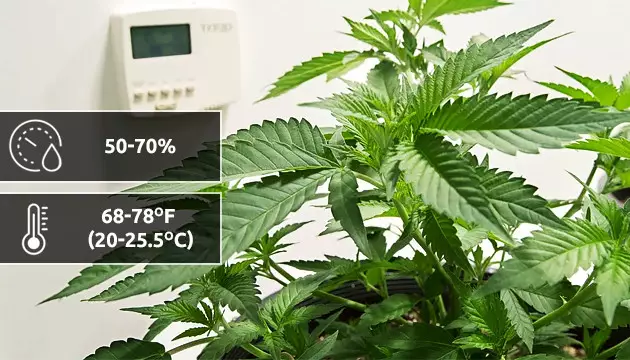
Creating The Right Grow Room Environment
Marijuana requires specific weather conditions to properly thrive, which is why it’s easier to grow in warmer, humid climates. During the vegetative stage, you need to closely monitor both temperature and humidity.
Your grow room temperature should be between 68-78oF (20-25.5oC), with humidity ranging from 50-70%.
Consistent air circulation is also crucial. If you’re growing indoors, it’s good to keep the grow room adequately ventilated to avoid stale air, in which mold thrives.
How Long Does The Marijuana Vegetative Stage Last?
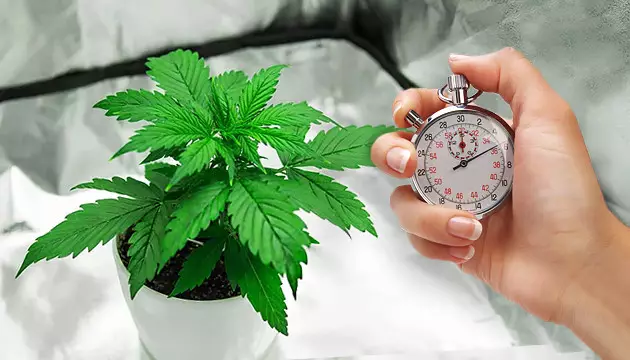
The vegetative stage length depends on the strain. Some have a short phase while others take far longer. It can be as short as 3 weeks (especially for autoflowering varieties) and as long as 15.
On average, depending on the strain and available time, growers let the vegetative stage continue for 4-8 weeks before switching to the 12-hour daily light cycles and triggering the beginning of the flowering stage.
How The Vegetative Stage Affects Yields
The vegetative stage is your plant’s opportunity to thrive as much as possible. It heavily relies on a good start from the germination and seedling stages, in addition to constant maintenance and proper water/food.
Since the vegetative stage involves the most development and growth, you’ll get higher yields if you allow your plants to vegetate for as long as possible.
Tips For A Perfect Vegetative Stage
Again, the vegetative phase is as complicated as it is crucial. This is your chance to set up your yield for success. Let’s look at a few simple tips to ensure that your harvest is as plentiful as possible.
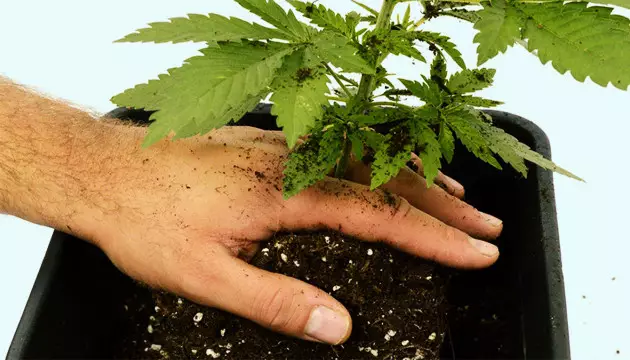
Transplant On Time
If you don’t transplant your cannabis on time, the roots could overgrow and block airflow, effectively killing your plant. When your seedling is bright green and develops additional leaf blades, that’s your cue to give the plant a larger home.
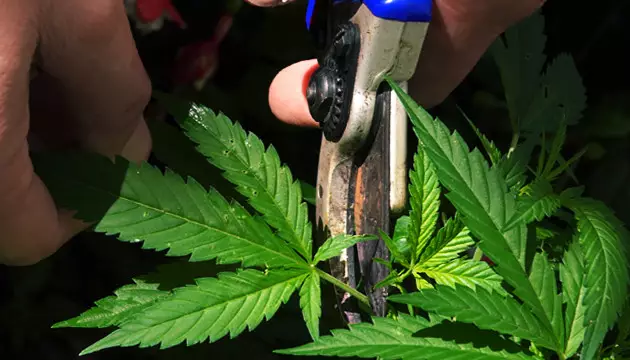
Prune The Cannabis Leaves
Growth is always a good thing, but there’s also such a thing as too much growth. Many leaves and stems die or grow unnecessarily, eating up much-needed energy.
Keep an eye out for and remove any dead or dying leaves. These are easy to spot since they’ll be brown or yellow. Also be sure to keep the bottom of your plant well-trimmed, removing any excess shoots. Doing this allows more energy to move up the plant where it’s needed most.
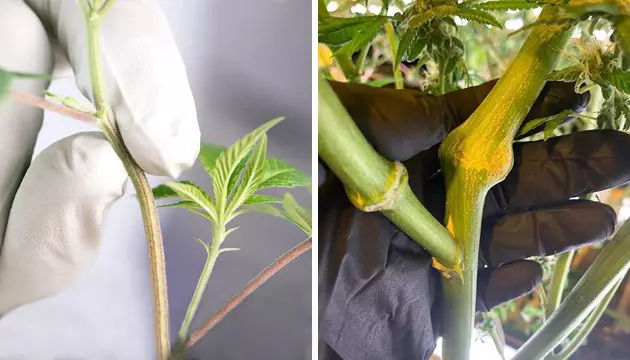
Train Your Cannabis Plants
On its own, marijuana will grow a single cola at the very top of the plant. Obviously, that’s not a lot of yield for the effort.
Training the plant allows it to grow multiple colas, giving you a much better harvest. There are different ways of training, with some more aggressive than others.
One of the most effective options is super cropping. You don’t need any fancy tools – just your bare hands will do. Find a location on the main branch, then gradually manipulate it with your fingers until it feels soft and weak. The plant should bend over and eventually heal itself. Be careful not to break the actual skin. You want to weaken the fibers inside so that the plant bends and exposes the lower areas to more light, hence more even growth.
The vegetative stage is perfect for training, as your plant will still have time to restore and get ready for flowering. There are plenty of options for training for both novice and advance growers. For more information, check out our article about training techniques.
Add CO2
Although outdoor growers don’t have this option, indoor growers can control the amount of carbon dioxide their plants receive. Adding additional CO2 to your indoor grow room helps with photosynthesis, improving cannabis vegetative light absorption and mass production.
Final Comments
Growing cannabis at home is rewarding, but it’s far from simple. Knowing how to properly handle the vegetative phase will maximize your yields and sense of accomplishment.
Don’t be discouraged if it doesn’t quite work out the first time. There are a lot of details to watch out for, but rest assured, everyone gets the hang of cultivation eventually. Keep trying and paying close attention to your plants’ stages, and you’ll eventually see good results.
Herbies Head Shop expressly refuses to support the use, production, or supply of illegal substances. For more details read our Legal Disclaimer.


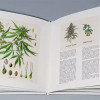

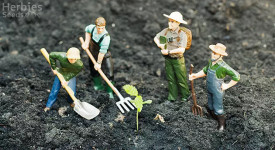
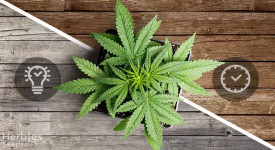
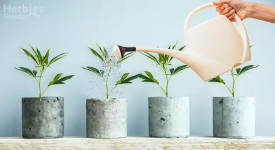



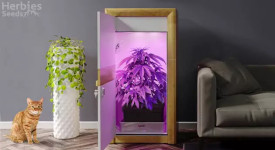

Thank you for leaving a comment for us!
Your feedback will be posted shortly after our moderator checks it.
Please note that we don’t publish reviews that: